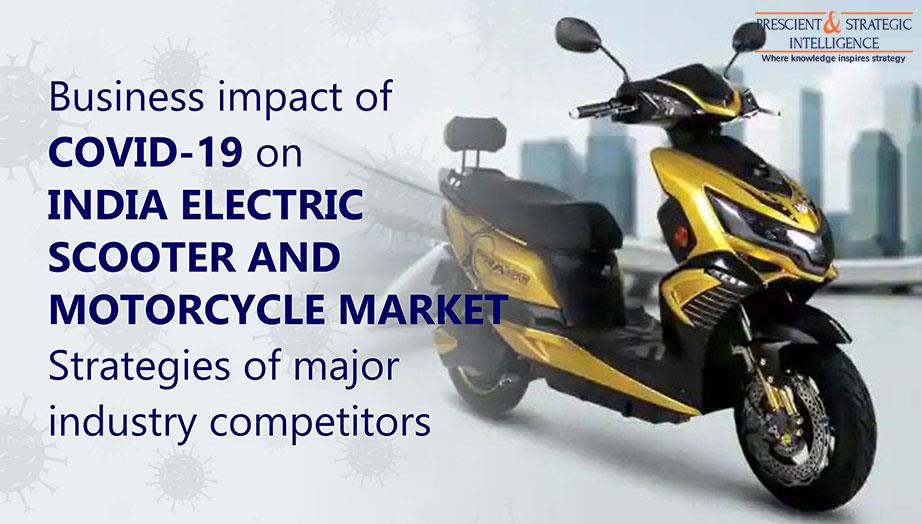
403
Sorry!!
Error! We're sorry, but the page you were looking for doesn't exist.
India Electric Scooters and Motorcycles Market Analysis, Emerging Trends, Key Players, Future Scope
(MENAFN- P&S Intelligence) The Indian electric scooter and motorcycle market will experience a 57.9% CAGR during the forecast period (2020–2025), on account of the high government subsidies, favorable regulatory policies, stringent emission norms, and entry of leading two-wheeler manufacturers in the country. Moreover, the rising environmental concerns, dipping lithium-ion (Li-ion) battery prices, increasing advancements in Li-ion batteries, and planned set up of manufacturing units will help the market reach $grow from a sale of 152.0 thousand units in 2014to 1,080.5 thousand units by end of 2025.
The regulatory environment and subsidies will go a long way in facilitating the Indian electric scooter and motorcycle market growth. The tax exemptions, financial incentives, and purchase rebate shave made these two-wheelers more viable for customers. Moreover, The government of India proposed a plan in 2019 to allow the sale of only electric two-wheelers from March 2025 onward. Moreover, the implementation of the Bharat Stage-VI (BSVI) emission norms from 1st April 2020 has boosted the production and sales of these electric vehicles (EVs).
Additionally, the falling prices of Li-ion batteries will act as a catalyst for the Indian electric scooter and motorcycle market growth. At present, most of the EV manufacturers import Li-ion batteries from South Korea, China, and Japan due to the scarcity of raw materials and an underdeveloped value chain. The import of batteries leads to high costs, and domestic production will reduce them. Owing to these reasons, most of the Li-ion battery developers in India are focusing on the development of batteries and related systems within the country.
Moreover, the increasing investments in the country’s e-two-wheeler sector by established manufacturers like Bajaj Auto Limited and TVS Motor Company Limited will fuel the growth of the Indian electric scooter and motorcycle market in the foreseeable future. The investments will help manufacturers pour in the high upfront capital required in the initial stages and setup a supply chain. The increased influx of money also helps in keeping the cost of electric two-wheelers low, while enhancing their quality.
Geographically, Karnataka and Delhi are two of the fastest-growing states in the Indian electric scooter and motorcycle market due to the surging government support, escalating environmental concerns, rising preference for clean and green vehicles, and soaring popularity of two-wheeler sharing services. Uttar Pradesh and Tamil Nadu are expected to hold comparatively larger shares in the market during the forecast period. The maximum demand for such EVs is generated from the tier 1 and tier 2 cities of these states.
Thus, the presence of a conducive regulatory framework and availability of an array of scooter and motorcycle models will propel market growth in the coming years.
The regulatory environment and subsidies will go a long way in facilitating the Indian electric scooter and motorcycle market growth. The tax exemptions, financial incentives, and purchase rebate shave made these two-wheelers more viable for customers. Moreover, The government of India proposed a plan in 2019 to allow the sale of only electric two-wheelers from March 2025 onward. Moreover, the implementation of the Bharat Stage-VI (BSVI) emission norms from 1st April 2020 has boosted the production and sales of these electric vehicles (EVs).
Additionally, the falling prices of Li-ion batteries will act as a catalyst for the Indian electric scooter and motorcycle market growth. At present, most of the EV manufacturers import Li-ion batteries from South Korea, China, and Japan due to the scarcity of raw materials and an underdeveloped value chain. The import of batteries leads to high costs, and domestic production will reduce them. Owing to these reasons, most of the Li-ion battery developers in India are focusing on the development of batteries and related systems within the country.
Moreover, the increasing investments in the country’s e-two-wheeler sector by established manufacturers like Bajaj Auto Limited and TVS Motor Company Limited will fuel the growth of the Indian electric scooter and motorcycle market in the foreseeable future. The investments will help manufacturers pour in the high upfront capital required in the initial stages and setup a supply chain. The increased influx of money also helps in keeping the cost of electric two-wheelers low, while enhancing their quality.
Geographically, Karnataka and Delhi are two of the fastest-growing states in the Indian electric scooter and motorcycle market due to the surging government support, escalating environmental concerns, rising preference for clean and green vehicles, and soaring popularity of two-wheeler sharing services. Uttar Pradesh and Tamil Nadu are expected to hold comparatively larger shares in the market during the forecast period. The maximum demand for such EVs is generated from the tier 1 and tier 2 cities of these states.
Thus, the presence of a conducive regulatory framework and availability of an array of scooter and motorcycle models will propel market growth in the coming years.

Legal Disclaimer:
MENAFN provides the
information “as is” without warranty of any kind. We do not accept
any responsibility or liability for the accuracy, content, images,
videos, licenses, completeness, legality, or reliability of the information
contained in this article. If you have any complaints or copyright
issues related to this article, kindly contact the provider above.

















Comments
No comment